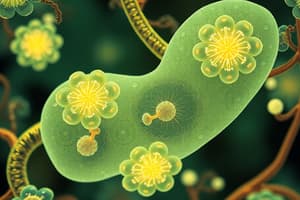Podcast
Questions and Answers
What is the pancreatic endocrine tissue?
What is the pancreatic endocrine tissue?
The pancreatic islets.
What are the main islet cell types?
What are the main islet cell types?
Alpha, beta, and delta cells.
What are the effects of glucagon when secreted between meals?
What are the effects of glucagon when secreted between meals?
Stimulates gluconeogenesis and glycogenolysis in the liver, raising blood glucose levels; stimulates fat breakdown in adipose tissue.
What is the effect of insulin secreted during and after meals?
What is the effect of insulin secreted during and after meals?
What effects does somatostatin have when released along with insulin?
What effects does somatostatin have when released along with insulin?
What are the main endocrine hormones secreted by the testes?
What are the main endocrine hormones secreted by the testes?
How does testosterone work?
How does testosterone work?
How does inhibin work?
How does inhibin work?
What hormones are secreted by the skin?
What hormones are secreted by the skin?
What hormones are secreted by the liver?
What hormones are secreted by the liver?
What hormones are secreted by the kidneys?
What hormones are secreted by the kidneys?
What hormones are secreted by the heart?
What hormones are secreted by the heart?
What hormones are secreted by the stomach and intestines?
What hormones are secreted by the stomach and intestines?
What are the three hormone classes?
What are the three hormone classes?
What are steroids derived from?
What are steroids derived from?
What are monoamines?
What are monoamines?
What are peptides?
What are peptides?
How are hormones transported to their target cells?
How are hormones transported to their target cells?
Flashcards are hidden until you start studying
Study Notes
Pancreatic Endocrine Tissue
- Pancreatic islets consist of endocrine tissue responsible for hormone secretion.
- Main islet cell types: alpha, beta, and delta cells, each producing distinct hormones.
Alpha Cells
- Secrete glucagon, which raises blood glucose levels during fasting.
- Stimulates gluconeogenesis (glucose synthesis) and glycogenolysis (breakdown of glycogen) in the liver.
- Promotes fat metabolism in adipose tissue; increases free fatty acid release.
- Glucagon secretion is triggered by low blood glucose or rising amino acid levels post high-protein meals.
Beta Cells
- Produce insulin, which lowers blood glucose levels after meals.
- Insulin facilitates nutrient absorption, promoting glycogen, fat, and protein synthesis.
- Acts as an antagonist to glucagon, inhibiting the use of stored fuels.
- Insulin insufficiency is linked to diabetes mellitus.
Delta Cells
- Secrete somatostatin alongside insulin during and after meals.
- Somatostatin limits stomach acid secretion, slowing gastric emptying.
- Reduces blood glucose spikes; works with amylin to prolong nutrient absorption.
Testes and Their Hormones
- Testes secrete testosterone and inhibin.
- Testosterone is regulated by luteinizing hormone (LH) from the pituitary, supporting sperm production and secondary sex characteristics.
- Inhibin, released from sustentacular cells, regulates follicle-stimulating hormone (FSH) to control sperm production.
Skin Hormone Secretion
- Keratinocytes convert cholesterol-like steroids into cholecalciferol, aiding vitamin D3 synthesis through UV exposure.
Liver Hormones
- The liver secretes various hormones, including a form of angiotensin, which is a vasoconstrictor that elevates blood pressure.
Kidney Hormones
- Kidneys secrete erythropoietin, stimulating red blood cell production in the bone marrow.
Heart Hormone Secretion
- The heart releases atrial natriuretic peptide (ANP), which lowers blood volume and pressure by promoting sodium and water excretion via the kidneys.
Stomach and Intestine Hormones
- Produce hormones related to digestion and appetite:
- Cholecystokinin: stimulates bile release from the gallbladder.
- Gastrin: increases stomach acid secretion.
- Ghrelin and leptin: regulate appetite, secreted by the stomach and adipose tissue.
Hormone Classes
- Three primary classes of hormones: steroids, monoamines, peptides.
Steroid Hormones
- Derived from cholesterol, synthesized in gonads and adrenal cortex.
Monoamine Hormones
- Small molecules derived from amino acids characterized by amino groups.
- Melatonin is synthesized from tryptophan; other monoamines from tyrosine.
Peptide Hormones
- Composed of long chains or rings of amino acids, synthesized through transcription and translation processes.
Hormone Transport
- Hormones circulate in blood; monoamines and peptides are hydrophilic and exist as unbound hormones.
- Steroids and thyroid hormones are hydrophobic, requiring transport proteins and existing as bound hormones.
Stimuli Influencing Hormone Secretion
- Hormone secretion is influenced by various stimuli, including changes in blood chemistry, neural input, and other hormonal signals.
Studying That Suits You
Use AI to generate personalized quizzes and flashcards to suit your learning preferences.




